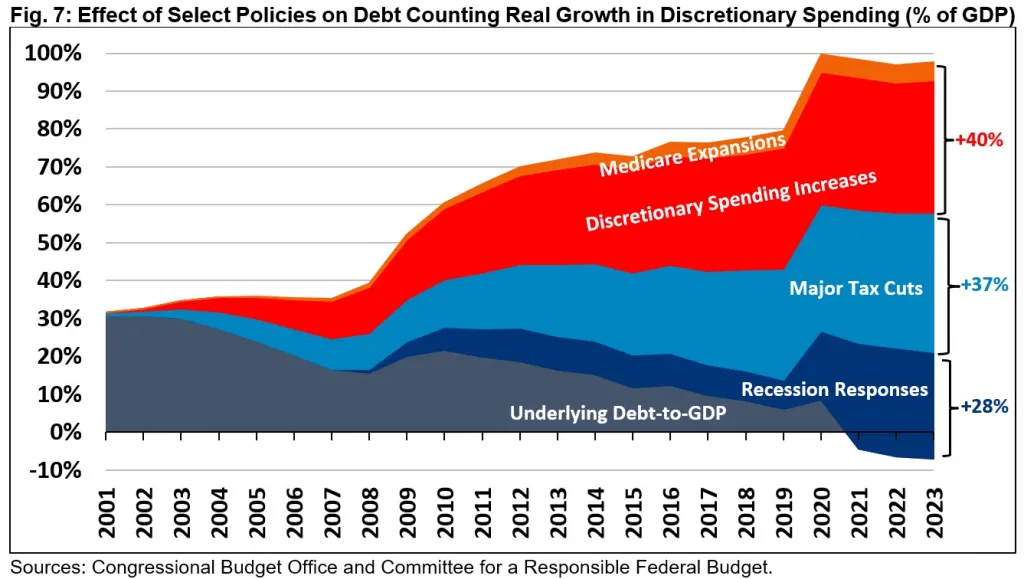How yesterday’s giveaways led to today’s deficits

What has caused the vast growth in deficits since the turn of the century, a brief period when the federal government ran surpluses? The answer: They were largely built in through mandatory spending legislation, mainly Social Security and healthcare, enacted before this century began.
Still, unfunded tax cuts and spending in response to the Great Recession and the COVID-19 pandemic played a significant role as well. Legislation on discretionary spending, meanwhile, has prevented it from declining as the real economy grew, hence providing no “pay-for” or funding for the other deficit-increasing actions.
Congress has essentially abandoned paying for most deficit-increasing actions, whether new or inherited from past legislation. Unfunded increases in mandatory spending, tax cuts and recession-related spending have led to an extraordinary growth in the nation’s debt and higher projected interest costs.
Two graphs from the Center for a Responsible Federal Budget’s extensive analysis explain the situation in detail.

The first and most informative graph outlines the share of gross domestic product in 2001 and 2023 spent and collected within major budget categories. Two-thirds of the growth in spending has come from health care and Social Security.
Some enactments occurred on the healthcare front — Medicare drug benefits under George W. Bush and new exchange subsidies and expansions of Medicaid under Obama — but the automatic growth in Medicare, Medicaid and other programs still dominates healthcare spending growth. Other mandatory programs also play a role, again with significant automatic growth built in from the past.
While Congress’s extraordinary delays in passing budget legislation for discretionary outlay programs receive much attention, they entail only a minority of total budget costs. Unlike mandatory programs, discretionary programs must go through an annual appropriations process. Because that part of the budget has no built-in growth from the past, Congress usually focuses on whether each of these programs should be increased or cut in real value relative to last year or the recent past.
The data show the results of that debate. Congress increased defense and non-defense discretionary programs from 2000 to 2023 — sometimes through new programs, often through expansion of old ones — over and above inflation at roughly the real rate of economic growth. Therefore, discretionary spending actions bear little responsibility for the nation’s rising debt-to-GDP.
Meanwhile, as real incomes grew and income became more concentrated among higher-income households this century, a larger share of income was falling into higher tax brackets. By itself, that would have raised individual tax revenues relative to GDP. However, several tax cuts, particularly in 2001, 2003 and 2017, decreased individual, corporate and estate tax revenues.
Meanwhile, interest on the debt also grew as substantial deficits added to the federal debt, though an unusual decline in interest rates until recently limited the consequences. That situation reverses as debt accumulates quickly, and old debt rolls over into new debt at higher interest rates.
Caveats are in order when doing this type of comparison. Among them, a long series of deficit reduction packages — particularly legislation in 1982, 1984, 1990 and 1993 — helped create a brief surplus at the turn of the century.
They weren’t the only factors in play. A stalemate between Democratic President Bill Clinton and the Republican Congress led to few deficit-increasing actions during his presidency. The baby boomers were in peak earning rather than retirement years. Capital gains receipts were unusually high. The collapse of the Soviet Union was continuing to add a peace dividend. And interest rates had been falling (and continued to fall until very recently).
After 2000, our elected officials abandoned sound fiscal policy rather than take advantage of a strong starting point. In simplest terms, Democrats have refused to address mandatory spending growth, and Republicans have sought more tax cuts so that they, too, could get credit for giving away money. They both refuse to fund the types of deficit-increasing actions required during economic downturns and other emergencies.
CRFB provided a different look at the data in another graph.

Suppose Congress enacted no new legislation after 2000 and let mandatory spending and taxes wind along their merry automatic path while discretionary spending only increased with inflation. Suppose, also, that the economy’s labor supply and output impossibly would have been the same each year. How, then, did legislation affect that path?

In that case, unfunded recession responses, significant tax cuts and discretionary spending look to bear almost all responsibility for the rising deficits. In effect, when the giveaways built in from the past remain unchecked and start dominating the total changes that occur over time, then new giveaways — whether spending increases or tax cuts — push us even further out on an unsustainable path.
Never in U.S. history has there been so much growth in debt scheduled in current law from past legislation. The old saw about an Irish farmer giving a visitor directions applies appropriately to this situation: “Well, sir, if I were you, I wouldn’t start from here.”
Eugene Steuerle is a fellow at and co-founder of the Urban-Brookings Tax Policy Center in Washington, D.C. and a board member for the Center for a Responsible Federal Budget.
Copyright 2023 Nexstar Media Inc. All rights reserved. This material may not be published, broadcast, rewritten, or redistributed.










